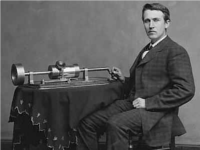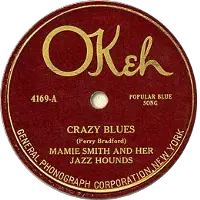Recording The Blues
“Thank God for recording. It’s the best thing that’s happened to us since writing” – Keith Richards, in his autobiography, ‘Life’ (Published 2010)
Keef was right. Sound recording is a cultural paradigm shift on a parallel with the rise of literacy. Before recording, music was only available to those within earshot of the musicians: wandering troubadours would carry their tunes around the region, but their audience was still small. Most people would spend their whole lives without hearing any music from outside their own community. The first decades of the 20th century yielded the technologies of recording, reproduction, amplification and radio, which allowed a tune to travel round the world in seconds. In cultural terms, this was a Big Bang.
 Emile Berliner developed a carbon microphone in 1977 and Edison’s cylinder recordings appeared in the same year, leading to the commercial production of the ‘nickelodeon’, an early juke-box, but the machine was huge, the cylinders were not durable and it only played one song! Berliner later developed the easily reproducible disc record in the 1890’s, which made the gramophone available for home use. Early recordings were dominated by speech and classical music, but recordings of popular music were made and sold in huge numbers. Recording and sound reproduction were still mechanical at this stage, but the development of the vacuum valve amplifier and the electronic microphone made sound available with good quality and volume. Marconi’s work in radio led to sound transmission with reasonable fidelity, so by the early 20’s the tools were available to make local music available to the world.
Emile Berliner developed a carbon microphone in 1977 and Edison’s cylinder recordings appeared in the same year, leading to the commercial production of the ‘nickelodeon’, an early juke-box, but the machine was huge, the cylinders were not durable and it only played one song! Berliner later developed the easily reproducible disc record in the 1890’s, which made the gramophone available for home use. Early recordings were dominated by speech and classical music, but recordings of popular music were made and sold in huge numbers. Recording and sound reproduction were still mechanical at this stage, but the development of the vacuum valve amplifier and the electronic microphone made sound available with good quality and volume. Marconi’s work in radio led to sound transmission with reasonable fidelity, so by the early 20’s the tools were available to make local music available to the world.
Blues and Gospel music were the dominant cultural expression of African American people of the rural southern States. Jazz was developing at the same time in the more urban environment of New Orleans and St. Louis, but the South had divisive ‘Jim Crow’ laws and the black population was economically and culturally repressed. Black performers couldn’t record their music, with white groups like The Original Dixieland Jazz Band making the first Jazz records, but after 1920 ‘race records‘, opened up an important new market. Radio stations and record companies operated a ‘de facto’ segregation, with very little crossover, so jazz and blues were largely confined to the black community until after WWII.
 The first commercial Blues record was Mamie Smith‘s ‘Crazy Blues’ in 1920, which sold hundreds of thousands of copies. Soon companies like Okeh and Columbia were producing records by dozens of the founders of the Blues. Bessie Smith became a big star after she signed for Columbia Records, and Ma Rainey had big hits with ‘Boll-weevil Blues’ (1923) and ‘See-see Rider’ (1924) for Paramount as did Blind Lemon Jefferson when he began his short but stellar career in 1926. In 1928, Tampa Red recorded his raunchy ‘hokum’ style ‘Tight Like That’ in Chicago, and Blind Willie McTell‘s hit ‘Statesboro Blues’ from the same year is still played by the Allman Brothers. Charley Patton‘s ‘Pony Blues’ (1929) was a highly influential country Blues hit, which set the template for much of what was to follow.
The first commercial Blues record was Mamie Smith‘s ‘Crazy Blues’ in 1920, which sold hundreds of thousands of copies. Soon companies like Okeh and Columbia were producing records by dozens of the founders of the Blues. Bessie Smith became a big star after she signed for Columbia Records, and Ma Rainey had big hits with ‘Boll-weevil Blues’ (1923) and ‘See-see Rider’ (1924) for Paramount as did Blind Lemon Jefferson when he began his short but stellar career in 1926. In 1928, Tampa Red recorded his raunchy ‘hokum’ style ‘Tight Like That’ in Chicago, and Blind Willie McTell‘s hit ‘Statesboro Blues’ from the same year is still played by the Allman Brothers. Charley Patton‘s ‘Pony Blues’ (1929) was a highly influential country Blues hit, which set the template for much of what was to follow.
The ‘plantation melodies’ were now spreading way beyond the range of a twanging guitar and a human holler.
